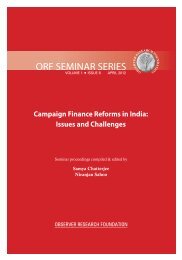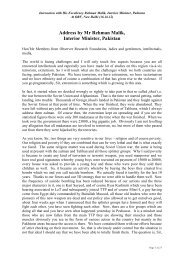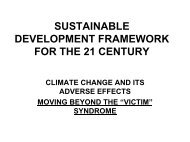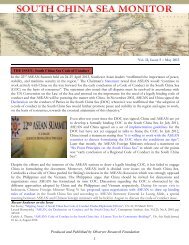ORF ENERGY NEWS MONITOR - Observer Research Foundation
ORF ENERGY NEWS MONITOR - Observer Research Foundation
ORF ENERGY NEWS MONITOR - Observer Research Foundation
You also want an ePaper? Increase the reach of your titles
YUMPU automatically turns print PDFs into web optimized ePapers that Google loves.
Exxon says growing its algae biofuels program<br />
TOP<br />
July 14, 2010. Exxon Mobil Corp said it opened a greenhouse facility to grow and test algae, the next step for<br />
its nascent biofuels program. Exxon said last year it would invest $600 million over the next five to six years<br />
attempting to develop biofuel from algae. If it met research goals, Exxon said it would spend more than<br />
originally budgeted in the next decade, $300 million of which would be allocated to its partner Synthetic<br />
Genomics Inc. The project would cost billions to fully develop, Exxon said. <strong>Research</strong>ers from Exxon and<br />
Synthetic Genomics will use the new facility to test whether large-scale quantities of affordable fuel can be<br />
produced from algae. Exxon's biofuel investment represents a tiny portion of the oil company's spending, which<br />
is set for $32 billion for just this year. That figure includes the budget of XTO Energy Inc, a natural gas company<br />
that the oil company bought. Synthetic Genomics, headed by entrepreneurial scientist Craig Venter, is a<br />
privately held firm focusing on gene-based research. Some strains of algae produce oil that can be converted<br />
into diesel and other fuels. To make biofuel from algae, sunlight and a large source of carbon dioxide would be<br />
needed. Venter said thousands of natural strains of algae are being screened for quantities that would make<br />
commercial production economical, but the sheer number of requirements means at some stage chosen strains<br />
will probably need genetic modification.<br />
European Union's Nations approve rules for carbon auctions after 2012<br />
July 14, 2010. European Union member states unanimously approved rules for auctioning most of their carbon<br />
permits after 2012, when the next phase of trading begins in the world’s largest emissions market. The EU,<br />
which has given away the majority of allowances since it started its cap-and-trade program in 2005, will require<br />
most emitters to purchase their allotment of permits in the phase that starts in 2013 and runs through 2020. The<br />
European Commission, the EU regulator, said countries will be able to apply for permission to run national<br />
auctions alongside a common European platform in the system’s third and later phases. Germany, Poland,<br />
Spain and the U.K. had asked for individual auctions. The U.K. government, which already has its own platform<br />
for selling CO2 permits, said that it “successfully secured concessions which will allow it to continue to hold its<br />
own national auctions. RWE AG, Germany’s second-biggest utility, is one of the companies that said it needs<br />
phase-three permits immediately to hedge the risk of power it is selling now for delivery in 2013 and beyond.<br />
West European utilities will no longer get free permits in the third phase, while east European power plants will<br />
have to buy 30 percent of their permits at auctions, with the amount rising to 100 percent by 2020.<br />
New Zealand emissions trade plan set for supply boost<br />
July 14, 2010. New Zealand's fledgling emissions trading scheme, the only national scheme outside Europe,<br />
stepped up from July 1 with the addition of industries that emit half the nation's greenhouse gases. But trading<br />
remains muted, bedevilled by lack of supply of offsets called New Zealand Units, with NZU prices trading below<br />
the NZ$25 price cap. In coming months, though, the supply picture is expected to change sharply as sectors<br />
entitled to free allocations of NZUs start to receive their offsets and as demand grows from companies that<br />
must meet carbon emissions obligations. New Zealand's total greenhouse gas emissions have risen 22 percent<br />
since 1990, the base year of the Kyoto Protocol. The country has pledged to have no increase from 1990 level<br />
emissions during Kyoto's 2008-2012 first commitment period. The emissions trading scheme is meant to help<br />
New Zealand meet its target, with forests that soak up large volumes of carbon dioxide playing a key role. TOP
















